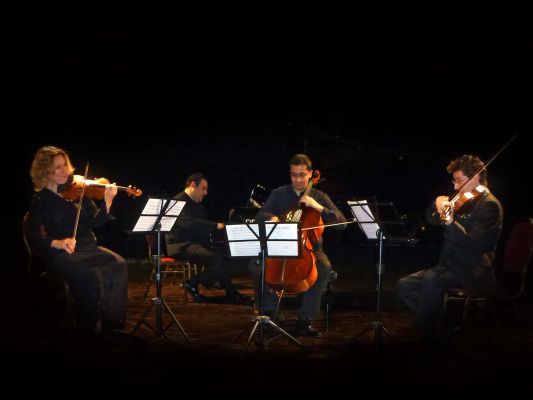June 20, 2014

On Sunday June 1, the AGBU Alex Manoogian Cultural Centre of Toronto hosted an evening of exquisite classical music with the AGBU Piano Quartet in its Toronto debut concert. The four talented young musicians, Aroussiak Baltaian (violin), Sarkis Baltaian (piano), Henrik Karapetyan (viola), and Hrant Parsamian (cello), all grant recipients from the AGBU Performing Arts Fellowship Program, were presented by the AGBU New York Special Events Committee (NYSEC). Created in 2008, the NYSEC helps showcase the achievements of these Armenian youth by having them tour various cities in the world, with an annual highlight concert at the Weill Recital Hall in Carnegie Hall, New York.
The four young musicians, all established in the United States and occupying enviable positions in universities and symphonic orchestras, presented a pleasantly varied program that combined lesser known gems with well known masterpieces. The first piece was Tagh to Resurrection (2002) for viola and percussion by Tigran Mansuryan (b. 1939), arranged for viola and piano by Henrik Karapetyan. Based on a 10th century Tagh by Grigor Narekatsi, called Havik, this work was audio recorded by Father Komitas in 1914. Perhaps the most striking originality about Karapetyan’s arrangement of the original drum part for piano was the marriage between the ancient Armenian “natural” scales used by the viola, with notes that are slightly higher or lower than the sounds accustomed to by the modern ear, and the fixed, tempered tuning of the piano. Karapetyan captured the subtle nuances of this work with great finesse, while Sarkis Baltaian accompanied the melody with utmost delicacy and a wide range of color.
Spanish composer Pablo de Sarasate (1844 -1908) was next on the program with his ever popular Zigeunerweisen (1878); but this time, the well known violin piece was performed on the cello by Hrant Parsamian. Alternating lush lyricism with rhythmic and bravura passages, the work is based on gypsy tunes. Parsamian displayed remarkable mastery of technique and beauty of tone throughout the performance.
The next composer, Garo Baltaian (b. 1934) was presented to the audience by his children, Aroussiak (violin) and Sarkis (piano), to whom the work is dedicated. Based on Armenian folklore, Song and Dance (1995) uses a ternary form to alternate the expressive “song” section with the rhythmic and fiery “dance” one, played with intense emotion and brilliant technical mastery by the Baltaian siblings.
Arno Babajanian’s (1921 – 1983) Piano Trio in F Sharp minor (1952) concluded the first half of this concert. One of the better known Armenian composers on the international scene, Babajanian was also a virtuoso pianist who has left scores of recordings of his own work. His Trio for piano, violin and cello, draws its material from Armenian folklore and displays intense lyricism and electrifying rhythms, presented in an envelope of modern sounding harmonies. This highly demanding work was played with passionate intensity and impressive technical mastery by Sarkis Baltaian, Aroussiak Baltaian and Hrant Parsamian.
The second half of the concert was dedicated entirely to German composer Johannes Brahms (1833 – 1897) with his Piano Quartet No. 1 in G minor, Op. 25. Another virtuoso pianist turned composer, Brahms wrote several masterpieces for his favourite instrument, including many chamber works. Throughout its four movements, the G minor Quartet covers a wide range of expression, from the structured sonata form, to a sombre Intermezzo, followed by a lyrical Andante, and finally a relentless “Rondo in Hungarian style” in which Brahms evokes gypsy music with its irresistible rhythms, bringing the piece to an explosive climax – and the audience to their feet! Once again, the four young musicians excelled in the interpretation of this monumental work and received a standing ovation from an ecstatic audience.
Dr. Araxie Altounian
